|

|
The following principles and definitions form the theoretical and conceptual background for the Participatory Community Peace and Conflict Assessment method: understanding of conflict, peace, and relationship to poverty, inclusiveness as well as the systemic approach.
Basic understanding of “conflict”:
Defined broadly, conflicts are situations where different actors or groups pursue incompatible goals. It is clear that the presence of antagonistic forces and incompatible goals are an integral aspect of social dynamics. Conflicts are in fact inevitable and at times even necessary for social change and to work towards sustainable peace and development. Therefore conflicts are not negative and need not be avoided. What matters is the way in which conflicts are addressed, managed, resolved and transformed. Thus conflict situations are a social or political phenomenon that can be constructive as well as destructive, depending on the means adopted.
The term latent conflict is used to describe situations of tensions, which may escalate into violence. According to Galtung, violence can either be direct or physical, structural or cultural. One form of latent conflict is structural violence described as situations where unequal, unjust and unrepresentative structures prevent humans from realising their full potential, thus extending the definition of violence beyond direct physical harm to the organization of society. Cultural violence refers to the exclusion or discrimination of ‘other’ cultural groups from equal access to resources.
In many settings managing conflicts can be seen as a potential force for positive social change and a visible demonstration of society adapting to a new political, economic or physical environment.
Basic understanding of “peace”:
The concept of peace is not an easy term to define. Mostly it is defined negatively by the absence of war or direct physical violence. Applied to nations, this would suggest that those not involved in violent conflicts with neighbouring states or suffering internal wars would have achieved a state of peace (e.g. “negative peace” being an absence of violence). The concept of negative peace is immediately intuitive and empirically measurable, and can be used as a starting point to elaborate its counterpart concept, “positive peace” which, according to Galtung, is about harmony being achieved by peace and social justice through equal opportunity, a fair distribution of power and resources, equal protection and impartial enforcement of law.
The Participatory Community Peace and Conflict Assessment method seeks to identify and support structures and institutions to create and then maintain some form of “positive” peace.
Relationship between poverty and conflict:
There is no direct causal relationship between poverty and conflict. Poor countries do not automatically descend into conflict and not all conflict-prone countries are poor. However, research has shown that countries with extremely high disparities between rich and poor (both in numbers and in resources available to them) are far more likely to be at risk of violent conflicts developing. A crucial parameter is how access to resources is determined and how wealth is allocated within society.
Therefore, poverty is not the cause of (violent) conflict but can itself be a consequence of conflict. The result of violent conflict is that it slows down economic growth erodes gains made in governance and undermines public confidence in state security forces and the credibility of lawmakers.
Inclusive approach:
Any participatory approach must ensure that all relevant stakeholders are involved (i.e. inclusiveness). An emphasis on social inclusion with adequacy of political participation, cultural expression, individual expression and group identity as well as access for the poor to land, resources, services and markets provides an additional dimension to conflict assessment. Carefully designed assessment strategies can bring disenfranchised stakeholders into equitable and collaborative negotiations with more powerful stakeholders, so helping to resist the capture of resources by elites and promote ‘pro-poor’ natural resource policies at the local level. In short, a process of conflict assessment has to ensure that it operationalises a ‘pro-poor’ participation in regions where effective participation is non-existent or weak. Marginalised persons or group actors who may be easily identified as stakeholders might however need support through information provision and training to enable them to negotiate and defend positions.
Stakeholders who do not have the capacity to make decisions and act on them are unlikely to become part of a collaborative decision-making process. Helping a group to become a social actor already in the analytical phase of the work is one strategy for “levelling a playing field,” as it gives legitimacy to a disempowered group. The method seeks to get greater political endorsement and improve involvement in the negotiation process for the marginalized persons and groups in society (i.e. of being more “inclusive”).
Systemic approach:
The Participatory Community Peace and Conflict Assessment approach uses key elements of the systemic approach outlined by Ropers et al. (Ropers, 2008). This includes: thinking in network structures, thinking in dynamic frames, thinking in (mental) models yet acknowledging perspective-dependency, recognizing that solutions are often embedded in the conflict system and concentrating on human beings and their learning processes.
Understanding of stakeholders / peace constituencies:
The participatory approach involves the conflict stakeholders, in other words all those engaged in or being affected by conflict. This includes individuals, groups and institutions contributing to conflict or being affected by it in a positive or negative manner, as well as those engaged in dealing with conflict. Stakeholders differ as to their goals and interests, their positions, capacities to realise their interests, and relationships with other stakeholders. Stakeholders can also be distinguished according to the level at which they are active (grassroots, middle level, top level). A positive view of stakeholders in a conflict setting is what is termed “Peace constituencies”. These can be described as a “lively network of actors who are bound neither to the state nor to any political party, who are pledged to nonviolence and committed to community-oriented purposes, and who thus build a counterweight to the ethno-politically or religiously segmented society”(Ropers).
Lederach defines three principles that are necessary to establish peace constituencies: indigenous empowerment, cultural sensitivity and a long-term commitment. This would offer a framework for sustainable local development and could thus make a long-term process of the transformation of conflict possible. These considerations also form the basis for the PCPCA method.
Figure 1: Links between levels of the PCPCA process in relationship to Lederach’s model
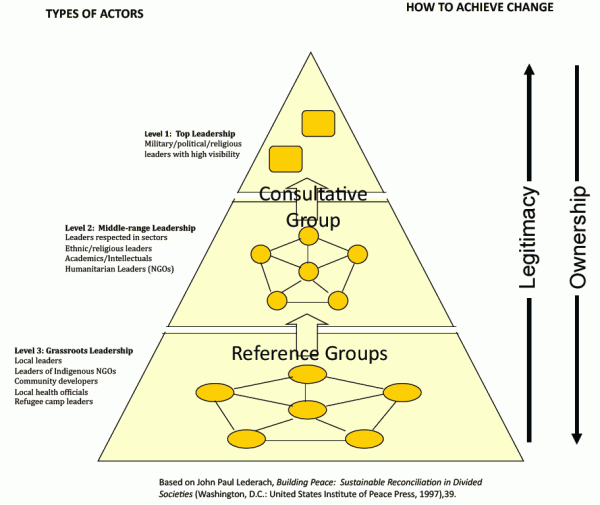
The following description of the Participatory Community Peace and Conflict Assessment – PCPCA method is divided three main sections:
A. Organisational structure, roles and responsibilities
B. Methodological approach
C. Necessary processes to be undertaken to complete the PCPCA
The following figure presents the main sections and the eleven processes recommended for the implementation of a participatory community peace and conflict assessment.
Figure 2: PCPCA sections and processes
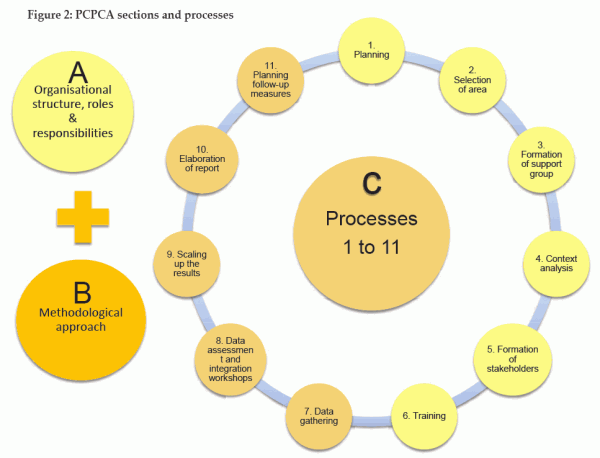
A. Organisational structure, roles and responsibilities:
A three-tier organisational structure is recommended:
- Reference Groups (RGs) – composed of grassroots stakeholders;
- Technical Working Group (TWG) – composed of experts from lead organisations conducting the Conflict Assessment (could be national line agencies, NGOs, donor organisations, national or international conflict transformation experts);
- Consultative Group (CG) – composed of regional/provincial/district (sub-national) leaders in government, police, military, religious organizations, NGOs and business community.
Each group has specific clear roles and responsibilities:
Figure 3: Organisational structure of the Participatory Community Peace and Conflict Assessment
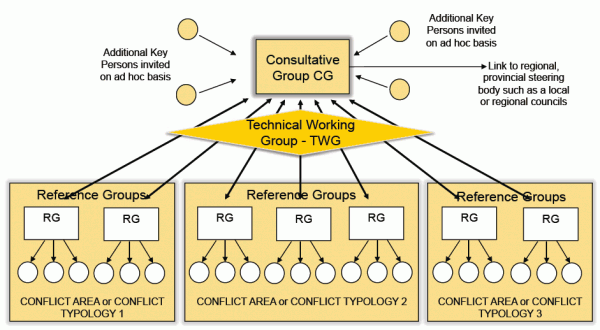
|
|

|
Although the processes depicted in the figure look sequential, in reality many of them run in parallel. In other words, some of the processes have to be undertaken simultaneously, and in a number of cases processes may require to be repeated.
- Reference Groups (RGs): The RGs are the central pillars of the concept. They are able to represent the grassroots level and have various informal roles in the community located on different levels within the grassroots (compare figure 1 derived from Lederach’s approach).
Since the actual Participatory Community Peace and Conflict Assessment is carried out by the RGs, these groups should include all actors and stakeholders from different social strata, with special consideration of marginalized groups and gender. The groups can also be understood as „peace constituencies“.
Informal political leaders/decision makers shall be engaged, but not formally included. The composition of the RGs shall represent the affected population of the conflict of the chosen typology (compare below part C, process 4: context analysis).
Due to the heterogeneity of the composition of the RGs within a conflict setting, trust building and ownership must be continuously addressed.
The RGs’ tasks include data gathering and information generation at a particular local level. This should take place in settings as diverse as possible.
- Technical Working Group (TWG): A key factor for success of the TWG is its capacity to bring together and facilitate the mutual enhancement of different competencies, which the members will bring with them. The TWG is expected to guide, coordinate and monitor the whole PCPCA process.
During the implementation of the PCPCA the TWG facilitates and provides the frame conditions and builds up an appreciating atmosphere for the process of Conflict Assessment to take place. By applying different tools they will help the RGs to moderate, structure and steer the process while their approach will be systemic and process oriented. This means that the task of the TWG is mainly to support the process, which is owned by the participants.
While the members of the TWG are not expected to interfere with the contents and results of the PCPCA, it may prove necessary to intervene during highly emotionally charged discussions or when imminent (manifest) conflict may result from the process.
The TWG also acts as the interface between the RGs and the CG; it will promote and guide the data gathering and information generation process and will also assist in compiling the overall results of the PCPCA. If necessary the team will moderate the different processes.
To ensure authenticity and reliability of the data, the Conflict Assessment should be conducted in the respective language proposed by the stakeholders. This requires translation into the particular language(s) at a later stage to be able to share the results of the Conflict Assessment.
The TWG will jointly develop and implement the training for the RGs, with the conceptual and technical know-how being provided by the appropriate experts. The training aims at exchanging tools and approaches of conflict transformation and to a foster a deeper understanding of those.
Essential is that the TWG members must be competent in being able to implement and supervise a participatory conflict. Ideally they should have profound technical and practical knowledge of conflict transformation and peace building as well as having a deep understanding of community mobilisation, facilitation and empowerment processes.
The TWG must be able to deliver training in various tools and methods (e.g. conflict profiles, timeline, conflict arena, conflict mapping, conflict pyramid, conflict trees, trend analysis, conflict scenarios, capacities and vulnerability analysis, do no harm analysis, mediation and negotiation, conflict sensitive interviewing, etc.).
- Consultative Group (CG): A key element in attaining legitimacy and ownership of the PCPCA process is the establishment of the Consultative Group (CG). Its members have the key role of providing guidance and advising on the integration of the results of the RGs into area wide Conflict Assessment results (district, province, region, etc.).
The CG works with and assists the RGs in implementing the Conflict Assessment. The Reference Groups discuss and jointly analyse the assessed data with CG, thus ensuring that the knowledge transfer to the next level of political decision-making takes place. This is also important to ensure the ownership of the results of the assessment.
The legitimacy of the CG stems from its function of coordinating and spreading selected information, building up networks and connecting the different levels of political decision-making. They are expected to recognise the role of informal political structures and involve respective perspectives in the conflict assessment process.
As a result of involving key stakeholders the CG will be able to provide advice to the RGs and TWG concerning the Conflict Assessment process and political steering.
It is recommended that the CG is a temporary body, designed only for the Participatory Community Peace and Conflict Assessment process. This is to avoid the creation of new parallel political bodies. However, the experiences and ability to involve key political stakeholders (inclusiveness) will be necessary for the overall process. The CG could also be created as part of a sub-committee from existing local or regional development or peace building committees.
B. Methodological approach:
The Participatory Community Peace and Conflict Assessment can make use of a host of different data collection and assessment methods and approaches. These can include:
- Key Informant Interviews (KIIs),
- Focus Group Discussions (FGDs)
- Integration workshops,
- Conflict profiles, timeline, conflict arena, conflict mapping, conflict pyramid analysis, conflict trees, trend analysis, conflict scenarios, capacities and vulnerability analysis, connector and divider analysis or a do-no- harm analysis.
The main data collection approach advocated by the method is the Key Informant Interviews, Focus Group Discussions and Integration workshops. Embedded in these tools are further analytic tools such as Conflict Mapping, Pyramid Analysis and Timeline Analysis. They are mainly to be used during FGDs as a group exercise.
C. Processes to be undertaken to complete the PCPCA
The following processes are suggested for an appropriate coverage of a large geographic area e.g. 2 million hectares with a population of 2 million people (roughly comparable to the land size and population of Slowenia or Kuwait).
Process 1: Overall Planning
Several background papers need to be elaborated and agreed upon as part of the overall planning of the PCPCA, these include:
- Elaboration and agreement of the concept: It is important that a conceptual framework for the PCPCA is drafted and subsequently agreed upon and communicated to all stakeholders. The concept paper should include the theoretical background, description of approach the process-design as well as logistical and administrative requirements. Moreover, it is also important to elaborate practical tools, methods and principles as a guiding support system during the whole process.
- Planning the key milestones: Key milestones to be completed include: selection of areas, implementation of contextual analysis, setting criteria and selection of members of the CG, the RGs as well as the TWG travel schedules, frequency and timing of meetings, risk monitoring system (e.g. travel authorisation for going into conflict affected areas); timing of the Key Informant Interviews and Focus Group Discussions, timeline for the RGs meetings and typology integration workshops, timing of the CG meetings, timing of the overall integration workshop, deadline for completion of the analysis report.
- Administrative and methodological planning: Designing of questionnaires and FGD guides with local language translation which are customized according to ethno-cultural requirements, meeting guidelines, selection process for RG and CG members, training materials, peer-to-peer trainings, training materials, preparing and conducting necessary trainings for the RG members, peer-to-peer trainings, selection process for RG and CG members, getting necessary administrative and political clearances to conduct such a wide ranging analysis.
- Financial and personnel planning: Aspects to be considered in the budget include costs for travel and transport of TWG and RG members, appropriate form of compensation for the time the RG members spend on conducting KII and FGDs (e.g. compensation for loss of potential income during these days, at least the minimum regional or national wage rate for rural workers should be considered) the costs involved in hosting integration workshops and meetings; materials and budget for the FGDs. Ideally, a full-time management including support secretariat is needed for managing and operationalising the whole process.
Process 2: Selection of area of focus of the PCPCA
Agreement has to be reached on the area where the conflict assessment will be undertaken. The scale of the planned assessment is an important factor in determining how the further steps in the process are to be organised. The larger the physical area is that needs to be covered and the more people who need to be involved, the more complicated it becomes to organise and implement a meaningful conflict assessment. This requires that a “sample-size” be selected.
This can be done in two stages:
- Initial selection of the larger area to be covered e.g. 2 million hectare area covering 2 million people.
- Selection of area typologies based upon the results of a context analysis (see process 4). The typologies should represent the majority of the conflicts in the area.
Process 3: Formation of the support groups (e.g. Consultative Group and Technical Working Group )
Prior to the next process steps being undertaken, the necessary support groups for the whole process need to be formed. This means that the members of the CG and the TWG need to be decided upon; both groups need to be constituted and their Terms of References clarified and agreed upon. The process of clarification of roles and responsibilities has to be undertaken in such a way to ensure that the CG takes ownership of the conflict assessment process. An important task of the two groups will then be to design and guide the context analysis. The key stakeholders (e.g. the reference groups) can only be determined during the context analysis. Essential is that the TWG members must be technically competent in conflict transformation and peace building as well as having a deep understanding of community mobilisation, facilitation and empowerment processes.
Process 4: Context analysis and identification of typologies
It is often difficult if not impossible to involve the majority of people living in the area in the conflict assessment. It is necessary to select a “sample” of stakeholders from the main conflict lines. The main conflict lines are determined through the context analysis. The context analysis involves either a literature assessment and/or a field reconnaissance. Developing conflict typologies is undertaken in order to be able to categorise different conflict types that take place in a specified area and in order to identify the possibilities and appropriate strategies for intervention measures.
While categorising conflicts is substantively normative, the approach still seen as a useful way to understand conflict dynamics and trajectories, and how these may continually evolve. Furthermore, the context analysis provides the information basis for developing the guiding questions, which shall be the focus of the participatory conflict assessment. As part of the context analysis previous conflict assessments and conflict transformation measures will be reviewed and assessed to derive lessons-learnt, best practices and approaches to be followed.
The following table provides an example how the typologies can be selected on the basis of the results of the context analysis:
Table 1: Example of selection criteria for determining typologies
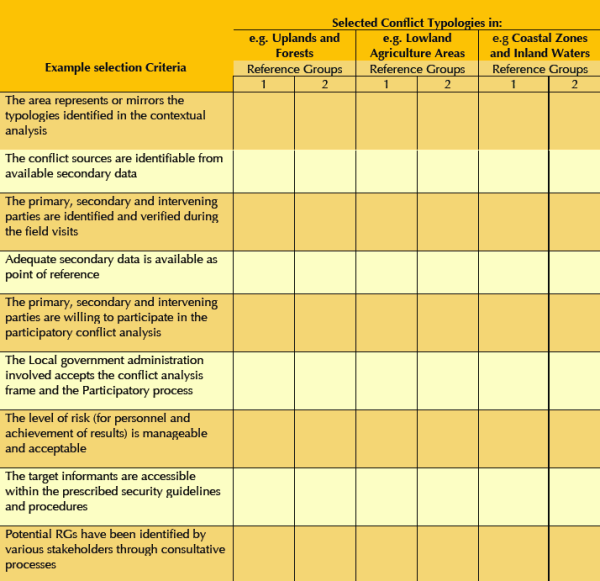
A small team of conflict experts would typically conduct the analysis. Helpful is good local area knowledge, something which international consultants are less likely to possess. A conflict typology or conflict characterisation can be along geographic lines (e.g. uplands, lowlands, coastal) or along ethnic lines (indigenous people, migrants, nomadic people), along economic lines (e.g. different wealth groups) or any other category deemed appropriate.
Once the conflict typologies have been identified, the number of stakeholders affected by the conflict can be determined. From this the sample size that will be taken from the main conflict assessment is determined. At least one or more samples from each conflict typology should be selected. The number to be selected should be determined by the ability to later interpolate the results across all conflicts in the area for a particular typology (e.g. scaling-up the results of the assessment). For very large geographic areas several samples per typology should be selected.
Process 5: Formation of stakeholders (Reference Groups)
The Participatory Community Peace and Conflict Assessment should be conducted by the RGs. The RGs shall include different actors from different social strata, including representatives of the marginalized groups and gender-balance. The process of selecting the RG members not only involves a lot of travelling for the TWG members but also the need for intensive discussions and assessments to determine and agree upon potential members of the RGs. It is also one of the most critical parts of the whole process. Without adequate reference groups being formed the whole process will lose legitimacy and accuracy.
The RG members are at the centre of the whole Participatory Community Peace and Conflict Assessment approach. They either represent the population directly affected by the conflicts or they possess the knowledge and experience in the concerned conflict typology. The idea of selecting the Reference Groups members (6-8 persons) is to:
- Facilitate community involvement and ownership in analyzing the conflict situation and to identify the locally tested and potential conflict resolution measures;
- Collect the data on specific conflict contexts and the past conflict resolution attempts;
- Communicate the status and direction of the joint Community Participatory Conflict Assessment;
- They will also present own views and represent a cross-section of viewpoints and concerns on existing and potential issues affecting the communities/interest groups with regard to the identified conflict lines;
- RG members also can be ideal resource persons for entry points for follow up work activities or measures.
Criteria for selection: With expected heterogeneity and variances in personal and social development settings, attitudes and behaviour, it is important to minimize chances of spoilage and conflicts within the RGs. The following criteria can be used to assist in the selection RG-members:
The member is a stakeholder and/or affected by the respective conflict;
Criteria for selection: With expected heterogeneity and variances in personal and social development settings, attitudes and behaviour, it is important to minimize chances of spoilage and conflicts within the RGs. The following criteria can be used to assist in the selection RG-members:
- The member is a stakeholder and/or affected by the respective conflict;
- The member is timely available to participate in the PCPCA;
- The member is willing and able to share her or his perception of the respective conflict line in a consensus oriented manner;
- The member is functionally literate
- Gender balance requires having a good balance within the group
- In good state of health
- Willingness to travel
- At least 18 years of age and below 60 years of age
- At least five years residence in the area
- Not an ideological and religious zealot (to avoid debates over dogmatic and preconceived notions at the onset)
Photo 2: Focus group discussion
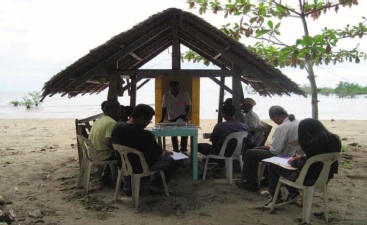
Process 6: Training
The TWG should develop and undertake the training of both the RG and possibly also CG members in the different conflict assessment tools, these can include the following:
- How to organise and conduct Key Informant Interviews, Focus Group Discussions or any other form of data collection deemed relevant.
- Basic training in some key tools and approaches of working on conflicts (e.g. conflict profiles, timeline, conflict arena, conflict mapping, conflict pyramid, conflict trees, trend analysis, conflict scenarios, capacities and vulnerability analysis, do no harm analysis)
- Approaches that help in the(self) reflection on handling conflicts;
- Tools and approaches on how to deal with emotionalized, tensed, deadlocked situations (e.g. negotiation, mediation);
- Approaches for ensuring the cultural acceptability and integration of the local setting into the data collection and analysis process;
- Tips and tricks on how to conduct conflict sensitive interviews.
Photo 3: Intention is to involve as many community members as possible in the process
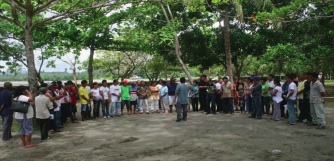
Photo 4: Training the reference group members is an important task for the success of the Conflict Analysis
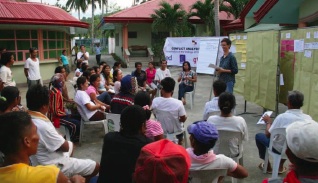
Process 7: Data gathering
Data collection and gathering is at the heart of the whole method. The reference group members are expected to undertake the data gathering. There are many different approaches how this can be done, including structured and unstructured questionnaires, interviews, group meetings. Three methods are being advocated for the PCPCA: key Informant Interviews (KII), Focused Group Discussions (FGD) and Integration Workshops. Practically, this means that the RGs go to the members of their communities and collect data. This should take place in settings as diverse as possible. The process of data gathering, assessment, integration and final integration into an overall Conflict Assessment is depicted in figure 4 (data collection and analysis 1a and 1b).
|
 |
KII and FGD are less about collecting facts and figures but more about investigating the specific conflict context as perceived by the participants. Thereby diverse perspectives will amplify the understanding of the conflict situation.
While FGDs aim at getting the broad picture of a stakeholder group, KIIs are specifically tailored for individuals. KIIs can be conducted whenever an FGD seems to be inappropriate due to the conflict or when there is a hierarchy or dependency to be considered (i.e. the involvement of powerful individuals such as mayors or governors, etc). Both the KII and FGD may also make use of different methods, tools and approaches such a pyramid analysis, conflict mapping, conflict timelines, focused questions, etc. Examples of these can be found in the literature references.
In view of the complexity and importance of the data gathering process, the TWG has to closely supervise, monitor and guide the RG members during this process. The TWG members should not interfere in the data gathering process. The only exception being if a (latent) conflict negatively affects the working process of an FGD and cannot be effectively handled by the RG. In this case the TWG has to apply their mediation and negotiation skills to facilitate a proper discussion and resolution of the issue.
Photo 5: Resource Mapping
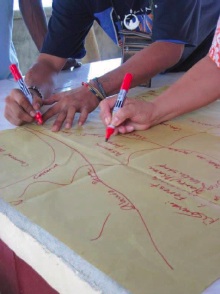
Photo 6: Conflict map
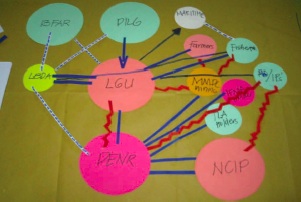
Photo 7: Detailed conflict map
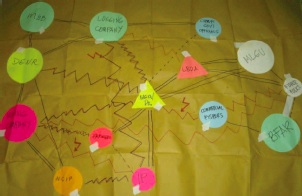
Process 8: Data assessment and integration workshops
An intra-typology process or dialogue should be undertaken during which the data within each typology is assessed. This allows the RG members to finalise the assessment and to prepare themselves for the inter-typology presentation during the CG meeting (compare joint analysis 2-3 in figure 4). A large part of the work involves assessing and interpreting the data that has been collected. If this was done in the local language there may also be a need to translate the information to an international language (e.g. English, French, Spanish, etc). Depending upon the number of typologies that have been identified, it may be necessary to conduct several data integration workshops between the different reference groups in any one typology as part of the process of scaling-up the information.
Process 9: Scaling-up results (e.g. conflict assessment) and gaining overall acceptance of the results by CG
Scaling-up the information (e.g. to the district, provincial or regional level) and enabling the RG members to present their findings to the members of the CG is a key objective of the workshop. During the workshop all members can then share their impressions, perceptions and recommendations on the presented findings. For example, if three typologies were selected for the assessment, the scaling-up would involve determining common issues of the typologies that are relevant across the entire area that has been selected. The CG may also make some additional comments and proposals to be included in the final report. A further key objective of the workshop is to ensure the necessary political legitimacy of the process.
The information and knowledge generated through the assessment can also be utilised by other sub-national or national planning institutions.
Photo 8: Key informant interviews
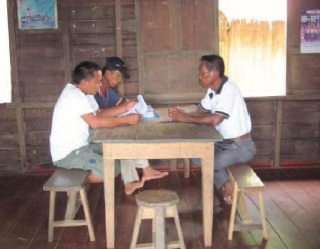
Process 10: Elaboration of the conflict assessment report
An important product of the Participatory Community Peace and Conflict Assessment is the overall report. It should be disseminated to all relevant stakeholders of the respective areas and to partners of development cooperation. The report should be based on an agreed upon structure and most important of all it should include an executive summary of the findings, results and recommendations.
The following structure can be used as a guide for a final report:
Table 2: Possible table of contents for final report
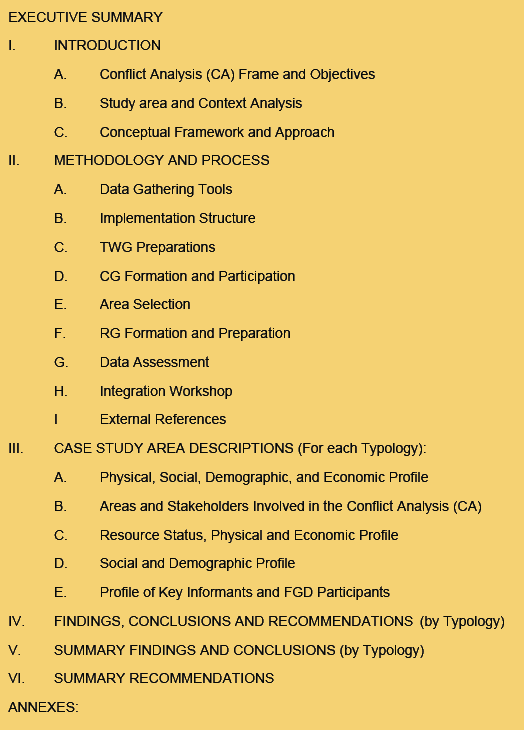
Process 11: Planning follow-up measures
A central part of the approach is that the whole process does not end when the Conflict Assessment results are presented. The intervention has now started and needs to be followed-up. A detailed proposal on who will undertake what as far as follow-up measures are concerned has to be completed as part of the whole process of peace building, conflict transformation and development. The presentation and discussion of the findings in diverse round table discussions in those areas where the Conflict Assessment was implemented can be an appropriate instrument to strengthen dialogue among the stakeholders and to initiate discussions on first steps to conflict transformation. This also would involve assisting the stakeholders in addressing the conflicts in a constructive manner. Measures could include assisting further negotiation, or mediation approaches, developing and implementing joint development activities as part of confidence building measures. If these measures are not planned, funded and implemented more harm can be done.
Photo 9: After the CA is completed, the work of addressing the conflicts really begins
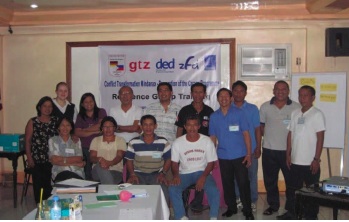
Photo 10: Ensuring all are involved during the Consultative Group meeting
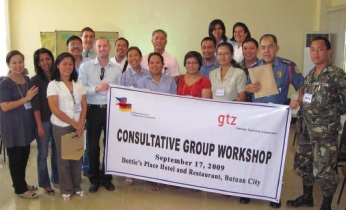
|